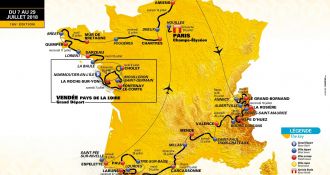

The route for the 2018 Tour de France was revealed earlier this week in the presence of top French riders, general classification favourites and anxious team staff. The route announced elicited a collective gasp. The largely clockwise and all-French route takes the race from the Pays de la Loire region on the west coast up to Brittany before crossing to Roubaix in the north-east. The first of two long transfers then takes the riders to the Alps before the final week in the Pyrenees and the customary finale in Paris.
First week snooze fest?
In 2017, Marcel Kittel won every stage between the prologue time trial and the first rest day. Not quite true, I'll grant you, but that first week has blurred into one long, straight, flat procession. Clearly, the route planners have learned from their mistake and thrown a little spice into the mix for 2018. Though a couple of the stages look on paper like they stretch across half of France (snore), there's a lot to look forward to. There's a team time trial on stage 3, two assaults on the Mur de Bretagne on stage 6, and possibly the biggest challenge of the whole race to Roubaix on stage 9. Halleluiah!
With a rare visit to the cobbles of Roubaix, we can expect to see endurance bikes making an appearance at the Tour de France, namely the appropriately named Specialized Roubaix and Trek's award-winning Domane.
{:A1534,A4808,A1497}
Sprinters' nightmare
One implication of the more multifaceted route, however, is that the pack arriving in Paris might be less of a sprinters' World Cup than we have come to expect. There are probably seven sprint stages at the very most, with very slim pickings after stage nine's visit to Roubaix. From that point onwards, some of the biggest hurdles in European cycling stand between the sprinters and the Champs-Elysées. Mark Cavendish, for one, is doubtful that many will make it to Paris.
At the launch of 2018 @letour route today. ABSOLUTELY BRUTAL. Some of the toughest stages I've ever seen. Sure not many sprinters in Paris. pic.twitter.com/1fpiag33Py
"” Mark Cavendish (@MarkCavendish) October 17, 2017
Innovative route planning
Besides the cobbles, the Tour organisers have done a sterling job of injecting some excitement into the Tour de France. Doubtless taking cues from the fateful stage nine of this year's Tour, stage 17 is just 65km in length, of which no fewer than 38 are uphill. The riders will crest the Peyragudes at km 15 before suffering up the 8.3% average Col de Val Louron. The stage finishes up the 16km Col de Portet, a Tour de France debutant, topping out at 2215m with a gradient averaging 8.7%. The middle week in the Alps is a little more predictable with old favourites including the Alpe d'Huez and Col de la Croix de Fer. The surprise package comes on stage 10 with a climb up to the Plateau des Glières. With 6km at 11% average, it is no mean feat, and that's before the 2km of rough track at the top!
Like the riders, the bikes will have to be all-rounders, capable of taking on mixed terrains including Alpine passes and northern cross-winds. Bikes like the brand new Specialized Tarmac or Pinarello's multiple Tour-winning Dogma - probably running some bigger, more gravel appropriate tyres than the usual racing type.
{:A1395,A3233,99803}
Varied terrain
The varied terrain of the 2018 Tour de France means that good bike handling will be key. Not only that, but also, the mechanics are going to have their work cut out. Cobbles, crosswinds and mountain dirt tracks will demand specialist kit and equipment for the difficult and unpredictable conditions. Tyre choice is going to play a key role in many stages, not least on the cobbles of stage 9 and the gravel section of the Col des Glières.
Eight rider teams
One big change which will probably be quite a small change when it comes down to it, is the slimming down of team size. Instead of the familiar nine riders, next year the teams will be restricted to eight. This is in response chiefly to safety concerns, but it's also hoped that it will add some excitement to the racing. Fewer riders mean fewer expendable domestiques and, in theory, greater pressure on leaders. However, bear in mind that only in one of the four Tours Froome has won did he finish with a full quota of nine. Will it make a difference?
There are a few things we can be pretty sure of about next year's Tour. The route appears more colourful than recent years, with short and sharp climbs as well as long and steep ones, cobbles, gravel and crosswinds, all guaranteed. Throw in an intense short mountain stage, and you've got an intriguing three-week race. Ultimately, with relatively few time trial kilometres and such a varied parcours, the rider wearing the yellow jersey in Paris will be the definitive all-rounder.